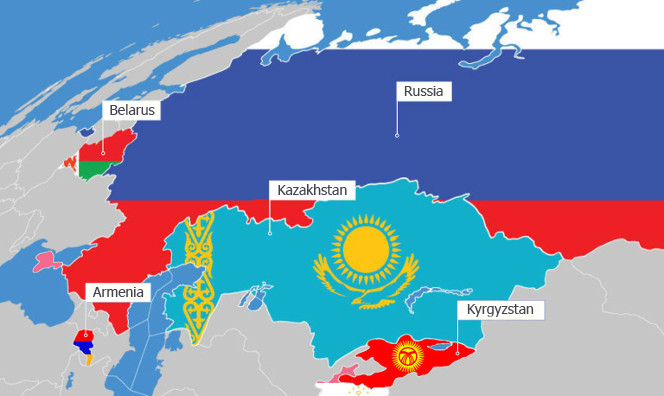Eurasian Economic Union : Russia, Belarus, Kazakhstan, Armenia, Kyrgyzstan
The Eurasian Economic Union (EEU or EAEU) is an international organization of regional economic integration having its own legal standing. It is the successor to the Eurasian Economic Community (EvrAsEs) and was established by the signing of the Treaty on the Eurasian Economic Union on 29 May 2014 by the leaders of Belarus, Kazakhstan and Russia. The Treaty came into force on 1 January 2015. The next day, on 2 January 2015, Armenia officially became part of the EAEU. Kyrgyzstan became a fully-fledged member in the middle of May.
The EEU ensures the free movement of goods, services and labour, as well as provides a coherent and unified policy in the sectors of the economy.

Eurasian Economic Union : Russia, Belarus, Kazakhstan, Armenia, Kyrgyzstan
Governance
Supreme Eurasian Economic Council
The Supreme Council is the Union's supreme authority, which is formed from the Heads of the Member-States.
Eurasian Intergovernmental Economic Council
The Council is the Union's body consisting of the Heads of the Member-States Governments.
Eurasian Economic Commission (EEC)
The EEC is a permanent regulatory body of the Union. Its members are appointed by the Council of the Commission and the Board of the Commission. The EEC is actively involved in the international cooperation in order to promote the vision of the Eurasian Community and to attract key partners from the European and Asia Pacific regions to the integration processes. The core tasks of the Commission are fostering the conditions to support the operation and development of the Union, and drafting proposals in the field of economic integration within the Union. The Eurasian Economic Commission, headquartered in Moscow, started its work in February.
Court of the EAEU
It is a court of justice of the Eurasian Economic Union, which ensures the uniform application of the EAEU Treaty and other Union treaties by the Union Member-States and bodies.
For more information, please visit http://www.eaeunion.org/?lang=en#
Value
If we compare the EAEU with other integration groups, despite the fact that many commentators draw parallels with the European Union, in fact, the EAEU is not a supranational body, it is rather close to the European Free Trade Association (EFTA).
The first incentive of post-Soviet integration is associated with relatively low competitiveness of many ex-Soviet goods compared to foreign ones. If you eliminate trade barriers, many manufacturing industries (textiles, food processing, woodworking, etc.) would find themselves under pressure from cheap imports and a better quality would be completely abolished.
Therefore, all countries of the present EEU are interested in creating an economic system of collective protection for national companies, which would temporarily block the way for foreign goods.
In addition, the integration is meant to restore and maintain the economic relations of the former Soviet republics, partially lost in the 1990s after the disintegration of a single state.










